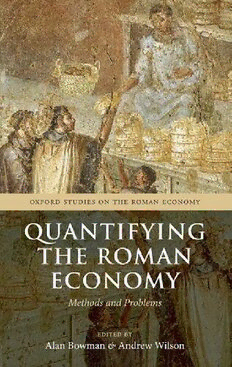Table Of ContentOXFORD STUDIES ON THE ROMAN ECONOMY
GeneralEditors
Alan Bowman Andrew Wilson
OXFORD STUDIES ON THE ROMAN ECONOMY
This innovative monograph series reXects a vigorous revival of
interest in the ancient economy, focusing on the Mediterranean
world under Roman rule (c.100 bc to ad 350). Carefully quantiWed
archaeological and documentary data will be integrated to help
ancient historians, economic historians, and archaeologists think
about economic behaviour collectively rather than from separate
perspectives. The volumes will include a substantial comparative
element and thus be of interest to historians of other periods and
places.
Quantifying the
Roman Economy
Methods and Problems
Editedby
ALAN BOWMAN
and
ANDREW WILSON
1
3
GreatClarendonStreet,Oxfordox26dp
OxfordUniversityPressisadepartmentoftheUniversityofOxford.
ItfurtherstheUniversity’sobjectiveofexcellenceinresearch,scholarship,
andeducationbypublishingworldwidein
Oxford NewYork
Auckland CapeTown DaresSalaam HongKong Karachi
KualaLumpur Madrid Melbourne MexicoCity Nairobi
NewDelhi Shanghai Taipei Toronto
WithoYcesin
Argentina Austria Brazil Chile CzechRepublic France Greece
Guatemala Hungary Italy Japan Poland Portugal Singapore
SouthKorea Switzerland Thailand Turkey Ukraine Vietnam
OxfordisaregisteredtrademarkofOxfordUniversityPress
intheUKandincertainothercountries
PublishedintheUnitedStates
byOxfordUniversityPressInc.,NewYork
#OxfordUniversityPress2009
Themoralrightsoftheauthorshavebeenasserted
DatabaserightOxfordUniversityPress(maker)
Firstpublished2009
Allrightsreserved.Nopartofthispublicationmaybereproduced,
storedinaretrievalsystem,ortransmitted,inanyformorbyanymeans,
withoutthepriorpermissioninwritingofOxfordUniversityPress,
orasexpresslypermittedbylaw,orundertermsagreedwiththeappropriate
reprographicsrightsorganization.Enquiriesconcerningreproduction
outsidethescopeoftheaboveshouldbesenttotheRightsDepartment,
OxfordUniversityPress,attheaddressabove
Youmustnotcirculatethisbookinanyotherbindingorcover
andyoumustimposethesameconditiononanyacquirer
BritishLibraryCataloguinginPublicationData
Dataavailable
LibraryofCongressCataloginginPublicationData
Dataavailable
TypesetbySPIPublisherServices,Pondicherry,India
PrintedinGreatBritain
onacid-freepaperbythe
MPGBooksGroupintheUK
ISBN 978–0–19–956259–6
1 3 5 7 9 10 8 6 4 2
Preface
This volume is the Wrst of a series of monographs to be published
under the general title OxfordStudies on the Roman Economy. Ithas
itsorigininaresearchprogrammedirectedbytheSeriesEditorsand
funded by the Arts and Humanities Research Council for Wve years
(2005–10).Thisproject,entitledTheEconomyoftheRomanEmpire:
Integration, Growth and Decline, starts from the realization that
further debate on the Roman economy needs to be grounded in a
better understanding of the evidence and that despite the lack of
statistics in ancient written sources there is nevertheless a vast mass
of archaeological and documentary (chieXy but not exclusively
papyrological)dataawaitingsynthesiswhichcouldprovideillumin-
ating pointers. The project will attempt a detailed analysis of major
areasoftheeconomywherequantiWablebodiesofarchaeologicaland
documentary data can be identiWed and compared. It will focus
therefore on population and urbanization, agriculture, trade and
commerce, and mining and coinage, examining for each a series of
performanceindicatorswhichcouldtrackvariationacrossspaceand
time, and might enable a comparison of performance against the
economiesofotherperiodsandcultures.Geographicallytheproject
willdrawonmaterialfromacrosstheentireempire,althoughEgypt
(becauseofthepapyrologicalevidence)willbeaparticularfocusfor
the documentary record. Chronologically we will cover the period
100bctoc.ad350,aimingtotestandquantify thegeneralimpres-
sionofeconomicgrowthtoc.ad200,andassesstowhatextentthe
thirdcenturymighthavebeenmarkedbystagnation,contraction,or
decline;andhowfartheremayhavebeensomesortofrecoveryinthe
earlyfourthcentury.
Besides assessing the rate and volume of economic growth and
subsequent contraction we will also consider how far the Roman
economy may have been integrated across the whole empire rather
than acting as a set of loosely linked regional economies; and the
interactionbetweenstatemechanismsofeconomiccontrolandlocal
‘free market’ behaviour. Were the two part of a coherent economic
vi Preface
‘system’? These general questions need to be approached through
severalunderlyingissueswhichinclude:thedriversandsymptomsof
ancient economic growth; levels of rationality in ancient economic
behaviour; and the appropriateness of applying recent analysis of
economicinstitutionsandbehaviourtotheRomaneconomy.These
will be examined through the analysis of a limited number of sig-
niWcant bodies of published direct and proxy data, archaeological
anddocumentary (particularly Greek papyri), within thefour main
diagnostic areas. SpeciWcally, we will consider the intensity of agri-
cultural and manufacturing production, levels of supply and de-
mand, the movement of goods over distance, the distribution of
population and the eVects of urbanization, scale of the metal and
money supply in relation to the behaviour of currency and prices,
institutional control and free markets, and the application of devel-
opmentsinancienttechnology.
Thesetopicswillbediscussedmoreexhaustivelyinfuturevolumes
which will be generated by a series of annual conferences, including
four on the main diagnostic areas of analysis (population and ur-
banization; agriculture; trade and commerce; and mining and metal
supply);thiselementiscrucialbecauseitallowsustoinvolveamuch
widerrangeofperspectivesandexpertise,andprovidesopportunities
fortestingandfeedbackonourapproaches.Astheresearchprogresses,
we intend to make available on our website (http://oxrep.class.ox.ac.
uk)aseriesofworkingpapers,andeventuallyalsothedatasetswhich
weandtheprojectResearchAssistants,DrMyrtoMalouta,DrAnnalisa
Marzano,DrDarioNappo,andDrHannahFriedman,havecollated,or
which have been oVered by collaborators. As part of the project a
doctoralstudent,BenjaminRussell,iswritinghisD.Phil.thesisonthe
economyofstonesculpture,focusingonquarrying,architecturalpro-
duction,sarcophagi,andhonoriWcportraitstatues.TheWnalobjective
ofthisprogrammeisavolumeinwhichwewillattempttosummarize
andsynthesizetheresultsoftheresearch.
Asapreliminary,itisobviouslyessentialtoframethekeyconcepts
and questions carefully and precisely, and to consider issues of
approach and methodology. This is what the present volume sets
out to do both at a general level and by illustrative analysis of
material drawn from the four diagnostic areas. The contributions
ofthevariousauthorsoriginally tooktheformofpresentationsata
Preface vii
colloquiumheldattheAshmoleanMuseumandtheClassicsCentre
inOxfordinSeptember2006.Theprogrammeconsistedofanumber
ofmainpapers,towhichbriefresponsesweremade.Followingthis,
therewereextendeddiscussionsoneachofthekeyareas.Thisformat
explains the shape and content of the present volume, inwhich the
mainpresentations(LoCascio,Fentress,Bowman,Wilson,Ponting,
Rathbone)andmostoftheresponsesandtheprefacestothediscus-
sions (by Bagnall, Jongman, Mattingly, Fulford, Harris, Hitchner,
Howgego, and Scheidel) are all represented. Some of the other
respondents and discussants did not feel able to make a substantive
written contribution to the volume but have kindly allowed us to
integrate their observations or comments where appropriate. We
hopethatthisstrategyhasgiventhevolumeaclearfocusandmade
itmorethanadisparateconglomerationofconferencepapers.
We are grateful to the AHRC for its Wnancial support of the
project, to the staV at the Classics Centre and the Ashmolean Mu-
seum, Oxford, for their assistance with arrangements for the collo-
quium out of which this volume arises, and to the various
contributors to the colloquium, both speakers and members of the
audiencewhocontributedpointsindiscussionatthetimeorsubse-
quently gave us feedback, especially Chris Wickham, Michael
McCormick, A. J. Parker, and Ben Russell. Catherine Hardman of
the Archaeology Data Service and Damian Robinson both gave
valuable advice on IT and data archiving matters at the planning
stage of the project, while Mark Austin has constructed the website,
with initial input from Neil Leeder and Ben Chad. Julia Strauss
kindly made available to us the data on Eastern Mediterranean
shipwrecks she had collected in the course of her doctoral thesis at
University College, London. Neither the organization of the confer-
ence nor the preparation of this volume could have been achieved
without the hard work and dedication of the project’s Research
Assistants,atthetimeMyrtoMaloutaandAnnalisaMarzano.
A.K.B.
A.I.W.
December2007
Contents
ListofContributors xi
ListofFigures xv
ListofTables xviii
INTRODUCTION: APPROACHES
1. Quantifying theRomanEconomy:Integration,
Growth,Decline? 3
AlanBowmanandAndrewWilson
I URBANIZATION
2. UrbanizationasaProxyofDemographicand
EconomicGrowth 87
ElioLoCascio
3. ResponsetoElioLoCascio 107
RogerBagnall
II FIELD SURVEYAND DEMOGRAPHY
4. Archaeology,Demography,andRomanEconomicGrowth 115
WillemJongman
5. PeoplingtheCountryside:RomanDemography in
theAlbegnaValleyandJerba 127
ElizabethFentress
6. PeoplingAncientLandscapes:PotentialandProblems 163
DavidMattingly
Contents ix
III AGRICULTURE
7. QuantifyingEgyptianAgriculture 177
AlanBowman
8. ResponsetoAlanBowman 205
RogerBagnall
IV TRADE
9. ApproachestoQuantifying RomanTrade 213
AndrewWilson
10. ApproachestoQuantifyingRomanTrade:Response 250
MichaelFulford
11. ACommentonAndrewWilson:‘Approachesto
QuantifyingRomanTrade’ 259
WilliamHarris
V COINAGE
12. RomanSilverCoinage:Mints,Metallurgy,and
Production 269
MatthewPonting
13. CoinageandMetalSupply 281
BruceHitchner
14. SomeNumismaticApproachestoQuantifying
theRomanEconomy 287
ChristopherHowgego
VI PRICES, EARNINGS, AND STANDARDS OF LIVING
15. EarningsandCosts:LivingStandardsand
theRomanEconomy 299
DominicRathbone

